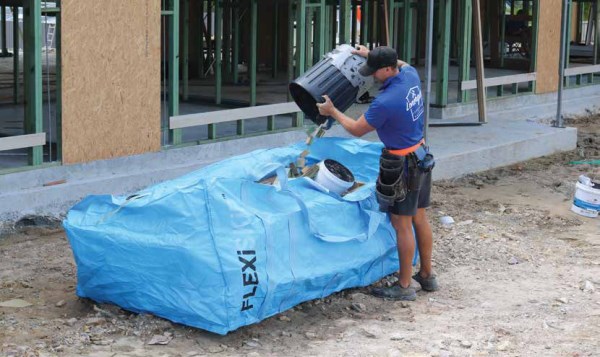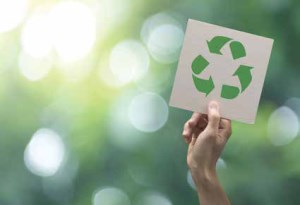After Disaster Strikes, What Happens to the Waste?

Forty percent of the waste Australia generates each year is from the demolition and construction sectors, with more than a third of it ending up in landfill. Insurance clean-up and repair work waste material are significant contributors.
How clean-up and repairs are carried out after a catastrophe can have a major impact on how much of this material ends up in landfill.
Reducing landfill
As part of its environment and sustainability strategy, leading Australian strata insurance specialist CHU is piloting a scheme with eco waste managers Handel Group to lessen impact on landfill.
In the aftermath of the Darlings Down floods and severe storms in south-east Queensland in February 2020, CHU is now working with handel: to recycle waste from the clean-up and repairs.
CHU is using handel:’s unique FLEXiSKiPs to collect and remove the waste. The skips are made from 100% recyclable material and can be easily erected on sites. The waste materials are later moved to handel:’s recycle partners to recycle.
“We are excited to partner with CHU, and their builder panel, to deliver landfill diversion and a suite of reporting tools to assist CHU monitor and meet their 2025 strategy,” said Steve Rohloff, Co-founder of the Handel Group.
Following the pilot, CHU is looking to encourage its panel of builders across Australia to use the skips so that the waste can be recycled.
“CHU’s 2025 strategy includes a major environment and sustainability filter and we are constantly seeking meaningful initiatives to help play our part,” said CHU CEO Bobby Lehane.
“While it’s absolutely vital for us to help customers get back on their feet after a catastrophe strikes, it’s important we don’t forget that’s not the end of the story. There’s a substantial amount of waste material generated in the clean-up and repairs following a catastrophe or a major event. With the demand on our landfill sites growing, insurers need to do their bit to help reduce the impact,” Mr Lehane said.
Some 80% of demolition and construction waste can be recycled or sold and handel: is looking at ways it can direct more of that waste to be recycled.

Recycling in action
CHU is committed to being a carbon-neutral business and last year signed a three-year agreement with environmental scientist/explorer Tim Jarvis’s Forktree Project that has the dual aims of helping combat climate change and biodiversity loss. The project involves replanting native trees and restoring native habitat on a 53ha former pastoral property on the Fleurieu Peninsula, South Australia. At the start of the project, the land had only 30-40 native trees left on it whilst the number should be in tens of thousands. After much hard work and active tree planting over the past year and a half, the property now has almost 5,000 native trees planted, with two thousand more to go in the ground in the next two months.
Tim has recently started this year’s planting and urgently needed stakes to hold the tree guards around his fledgling trees in place. CHU was able to assist Tim in sourcing and supplying 4,500 of Integrated Recycling’s composite recycled plastic tree stakes manufactured from recovered plastics, including agricultural films, bottles, pipes and drums combined with organic fibre. Material that would otherwise potentially end up in landfill or worst case as plastic pollution in the broader environment. Tim is really pleased with the results especially given the longer life expectancy of the stakes, superior strength compared with traditional wooden stakes and the fact that no trees need to be harmed to make them. A win-win!
“That’s just one practical way recycling can help the environment,” said Lehane.
Significance of the Forktree Project
The Forktree Project involves re-establishing tens of thousands of native trees and shrubs on the property that will in turn bring back native animals, insects and birds as well as sequestering tens of thousands of tonnes of carbon. (To put it in perspective, the average Australian’s carbon footprint each year is roughly 25 tonnes).
“Restoring this once pristine land in such an incredible part of Australia is important to do, coming at a globally critical time for species/habitat loss and climate change,” said Jarvis. This is especially important given that Australia is one of seven countries responsible for more than half of global biodiversity loss.
Australia is however also one of the top countries globally with the space to plant trees on spare or underutilised land. Collectively, if we planted trees on all the suitable, spare land that existed globally we could store over 200 billion tonnes of carbon and buy about 20 years in the fight against climate change.
“What is happening on the ground at Forktree is really important, but the real value lies in the positive example it sets for others to follow,” said Jarvis. Smaller farms and rural properties constitute between 5-10% of Australia’s agricultural land, covering tens of millions of hectares and so have the potential to be real game-changers.
This article was supplied by CHU Underwriting Agencies
Disclaimer: CHU Underwriting Agencies Pty Ltd (ABN 18 001 580 070, AFS Licence No: 243261) acts under a binding authority as agent of the insurer QBE Insurance (Australia) Limited (ABN 78 003 191 035, AFS Licence No: 239545). Any advice in this article is general advice only and has been prepared without taking into account your objectives, financial situation or needs.
View Comments
(0)